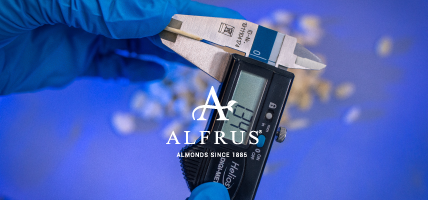
Alfrus almonds lifecycle – From the almond orchard to the table
Tasting an almond is like living a journey that begins in the field and ends on your table.
We want to reveal the secrets of this journey discovering taste, telling you all about the stages that our Californian almonds go through to make their way to you, step by step.
From their cultivation to processing, each stage of this lifecycle is important in the process leading the almond tree to give us that seed we love. A fruit that we at Alfrus commit to bring, tastier than ever, in the best food and confectionery industries.
VEGETATIVE REST
From November to January, during the cold and wet Californian winter, the almond tree goes through a phase of dormancy. During these months, the soil stores up rainwater for the upcoming growing season, while the tree gathers nutrients and energy for the new crop. When this period is about to end, small buds begin appearing on each branch, in preparation for bloom.
BLOOMING
Between mid-February and mid-March, we witness the wonderful stage of flowering. An explosion of beauty which paints whole almond groves in California with white and pink nuances.
Part of almond trees’ varieties in nature are self-pollinating. Therefore, it is necessary to plant different and compatible cultivars, in order to obtain a fruitful harvest. The presence of pollinators is also fundamental: our dear bees are brought by beekeepers throughout California, to help pollinating the crops.
DEVELOPMENT
From March to June, almond kernel goes through a stage of development, maturing and growing slowly. The shell surrounding it hardens while the outer hull protects it all.
Once the weather heats up, the farmers we rely on, begin irrigating the orchards, in order to support the growing crop through sustainable practices, including the responsible use of water as a resource.
HULLS CRACKING OPEN
In July, almond hulls grow to full size and, by splitting open, they allow the almond to dry and reach the right volume and flavor. Shortly before harvest, the hulls open completely.
HARVEST
The long awaited harvesting phase takes place from August to October. A long and meticulous operation, aimed at selecting only the best fruits of this hard work.
The harvest happens through the use of mechanical shakers, which gently make the fruits fall into hullers, without damaging the tree.
DRYING
Almonds are then left to dry, with the help of dryers.
SHELLING
The next step in this process is the removal of the shell and any debris from the orchard, usually through rollers. The Californian growers we rely on practice a zero waste approach, so they make sure none of these scraps is wasted.
SIZING
Once shelled, almonds can be directly commercialized or they are calibrated and then sent to processing lines, as in our case.
Sizing is the operation which includes the mechanical selection of the different seeds according to their size or weight.
STORAGE AND DELIVERY
Almonds are then stored under controlled conditions, in order to maintain their quality, until they are shipped to our processing plants, where they will be transformed into valuable food ingredients.
PROCESSING
Almonds can be processed in many ways, obtaining different versions and sizes, from almond flour to Marzipan. But in any shape or size, these small seeds represent one of the most important natural supplements within a healthy and complete diet.
CONSUMPTION
At the end of this cycle, our products and almond based ingredients will be used by food companies that choose us to create tasty confectionery preparations, desserts and fine gastronomic specialities. A full of goodness and well-being.
Almonds lifecycle is a natural journey we try to respect even in the stages following their ripening and harvesting. Because the high quality and sustainability of Alfrus almonds are our daily calling card. The ingredients of excellence.
29 April 2023






